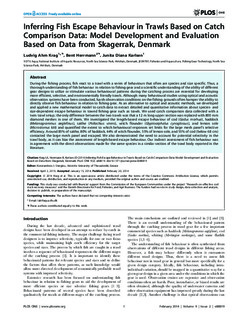| dc.contributor.author | Krag, Ludvig Ahm | |
| dc.contributor.author | Herrmann, Bent | |
| dc.contributor.author | Karlsen, Juanita Diana | |
| dc.date.accessioned | 2019-02-15T17:17:24Z | |
| dc.date.available | 2019-02-15T17:17:24Z | |
| dc.date.created | 2015-01-14T10:44:10Z | |
| dc.date.issued | 2014-02-20 | |
| dc.identifier.issn | 1932-6203 | |
| dc.identifier.uri | http://hdl.handle.net/11250/2585773 | |
| dc.description.abstract | During the fishing process, fish react to a trawl with a series of behaviours that often are species and size specific. Thus, a thorough understanding of fish behaviour in relation to fishing gear and a scientific understanding of the ability of different gear designs to utilize or stimulate various behavioural patterns during the catching process are essential for developing more efficient, selective, and environmentally friendly trawls. Although many behavioural studies using optical and acoustic observation systems have been conducted, harsh observation conditions on the fishing grounds often hamper the ability to directly observe fish behaviour in relation to fishing gear. As an alternative to optical and acoustic methods, we developed and applied a new mathematical model to catch data to extract detailed and quantitative information about species- and size-dependent escape behaviour in towed fishing gear such as trawls. We used catch comparison data collected with a twin trawl setup; the only difference between the two trawls was that a 12 m long upper section was replaced with 800 mm diamond meshes in one of them. We investigated the length-based escape behaviour of cod (Gadus morhua), haddock (Melanogrammus aeglefinus), saithe (Pollachius virens), witch flounder (Glyptocephalus cynoglossus), and lemon sole (Microstomus kitt) and quantified the extent to which behavioural responses set limits for the large mesh panel’s selective efficiency. Around 85% of saithe, 80% of haddock, 44% of witch flounder, 55% of lemon sole, and 55% of cod (below 68 cm) contacted the large mesh panel and escaped. We also demonstrated the need to account for potential selectivity in the trawl body, as it can bias the assessment of length-based escape behaviour. Our indirect assessment of fish behaviour was in agreement with the direct observations made for the same species in a similar section of the trawl body reported in the literature. | nb_NO |
| dc.language.iso | eng | nb_NO |
| dc.publisher | PLOS One | nb_NO |
| dc.rights | Navngivelse 4.0 Internasjonal | * |
| dc.rights.uri | http://creativecommons.org/licenses/by/4.0/deed.no | * |
| dc.title | Inferring Fish Escape Behaviour in Trawls Based on Catch Comparison Data: Model Development and Evaluation Based on Data from Skagerrak, Denmark | nb_NO |
| dc.type | Journal article | nb_NO |
| dc.type | Peer reviewed | nb_NO |
| dc.description.version | publishedVersion | nb_NO |
| dc.rights.holder | © 2014 Krag et al. This is an open-access article distributed under the terms of the Creative Commons Attribution License, which permits unrestricted use, distribution, and reproduction in any medium, provided the original author and source are credited. | nb_NO |
| dc.source.journal | PLoS ONE | nb_NO |
| dc.identifier.doi | 10.1371/journal.pone.0088819 | |
| dc.identifier.cristin | 1197445 | |
| cristin.unitcode | 7566,2,0,0 | |
| cristin.unitname | Sjømatteknologi | |
| cristin.ispublished | true | |
| cristin.fulltext | original | |
| cristin.qualitycode | 1 | |

